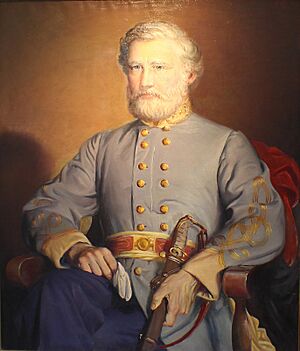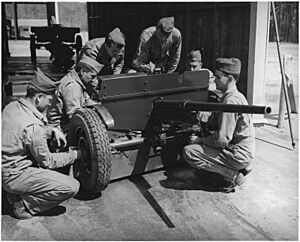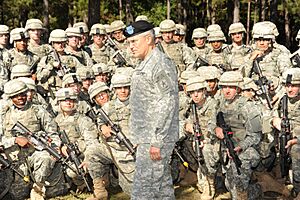Fort Moore facts for kids
Quick facts for kids Fort Moore |
|
|---|---|
| eponyms: LTG Hal Moore, USA and Julia Compton Moore | |
| Part of Training and Doctrine Command (TRADOC) Forces Command (FORSCOM) Special Operations Command (USSOCOM) |
|
| Columbus, Georgia Metropolitan Statistical Area Chattahoochee County, Georgia (93%) and Russell County, Alabama (7%) ≈182,000 acres (74,000 ha, 284 sq mi, 740 km2) |
|

Maneuver Center of Excellence
|
|
| Coordinates | 32°21′58″N 84°58′09″W / 32.36611°N 84.96917°W |
| Type | Army post |
| Site information | |
| Controlled by | |
| Site history | |
| Built | 1909 |
| In use | 1918–present |
| Garrison information | |
| Garrison | Units and tenant units
|
Fort Moore is a large United States Army base located near Columbus, Georgia. It sits right on the border between Georgia and Alabama. Every day, more than 120,000 people, including soldiers, their families, and civilian workers, are part of the Fort Moore community.
This base is a key place for the Army to train and send out soldiers for their missions. It's home to important schools like the United States Army Armor School and the United States Army Infantry School. It also hosts special units like parts of the 75th Ranger Regiment.
Fort Moore was first set up in 1918 as Camp Benning. It was named after Henry L. Benning, a general from the Confederate States Army during the American Civil War. In 1922, it became Fort Benning. Later, in 2005, it changed into the Maneuver Center of Excellence. This meant that different Army schools and training centers were brought together here. For example, the Armor School moved to Fort Moore from Fort Knox.
Contents
Why the Name Changed
Fort Moore was originally named after Henry L. Benning, a general who fought against the U.S. Army during the American Civil War. Many U.S. Army bases were named after Confederate generals.
After national protests in 2020, the U.S. Congress decided to look at renaming these military bases. A special group called the Naming Commission suggested that Fort Benning be renamed Fort Moore. This new name honors Lieutenant General Hal Moore and his wife, Julia Compton Moore. Both of them are buried at the base.
On October 6, 2022, the Secretary of Defense agreed to the change. The official renaming ceremony happened on May 11, 2023.
A Look at Fort Moore's History

Camp Benning opened on October 19, 1918. It first provided basic training for soldiers after World War I. Even Dwight D. Eisenhower, who later became a U.S. President, served here in 1918 and 1919.
In February 1920, Congress decided that Camp Benning would be a permanent military base. They gave over $1 million for new buildings for the Infantry School. By the fall of 1920, more than 350 officers and 7,000 troops lived at Camp Benning. The base was renamed Fort Benning in 1922.
Developing the Base
In 1924, General Briant H. Wells became the fourth leader of the Infantry School. He created a plan for building permanent structures on the base. He also made sure there were plenty of outdoor and fun activities for the soldiers. During his time, places like Doughboy Stadium, Gowdy Field, the post theater, and Russ swimming pool were built. Doughboy Stadium was built by soldiers to remember their friends who died in World War I.
In 1927, Lt. Col George C. Marshall became the assistant leader of the base. He made big changes to how soldiers were trained. Marshall, who later became the Army Chief of Staff during World War II, believed that many lives were lost in World War I because of not enough training. He wanted to make sure this didn't happen again. He and his team completely changed the training system at Fort Benning. These changes are still known as the "Benning Revolution." Marshall also created the Marshall Plan to help rebuild Europe after World War II and won the Nobel Peace Prize in 1953.
Fort Moore During World War II
In August 1940, a group of 48 volunteers, known as the Parachute Test Platoon, made their first jump over Lawson Field at Fort Benning. This was after a lot of training. These 48 soldiers were the start of America's Airborne Infantry.
During World War II, Fort Benning was a very large base. It could house almost 100,000 soldiers. One important unit trained here was the 555th Parachute Infantry Company. This unit was special because it was formed by black American soldiers. They were trained at Fort Benning to be "smoke jumpers," fighting forest fires in the Pacific Northwest. This was because there was a concern that the Japanese military might be setting fires using special balloons.
Training Towers and Modern Changes
The United States Army Airborne School at Fort Moore has three tall towers, each 249 feet (76 meters) high. These "Free Towers" are used to train paratroopers to jump safely. They were designed like the parachute towers at the 1939 World's Fair in New York. There used to be four towers, but one was knocked down by a tornado in 1954.
In 1984, the School of the Americas moved to Fort Benning from Panama. Later, it was renamed the Western Hemisphere Institute for Security Cooperation. This change happened after some concerns were raised about the school.
Fort Moore also has a special training area called McKenna Military Operations in Urban Terrain (MOUT). Army engineers built it to look like a European village, with 15 buildings including a church and houses. Soldiers use this area to practice fighting in city environments.
What's at Fort Moore Today
Fort Moore is located in parts of Muscogee, Chattahoochee, and Marion counties in Georgia. A small part of it is also in Russell County, Alabama.
The base has four main areas: Main Post, Kelley Hill, Sand Hill, and Harmony Church.
Main Post
The Main Post is where you'll find the base headquarters, McGinnis-Wickham Hall. It's also home to the Officer Candidate School and the Airborne School. Near the headquarters is the Ranger Memorial and the National Infantry Museum. The United States Army Infantry School holds its graduation ceremonies on Inouye Field. This field has soil from famous battlegrounds around the world, like Yorktown and Normandy.
Kelley Hill
Kelley Hill used to be home to the 3rd Brigade Combat Team of the 3rd Infantry Division. This brigade included different types of battalions, like infantry and armor units. In 2015, these battalions were deactivated. Now, a new unit called Task Force 1-28 is located here.
Sand Hill
Sand Hill is the main training area for new infantry soldiers. The 198th Infantry Brigade and 197th Infantry Brigade are based here. They are responsible for Infantry One Station Unit Training (OSUT), which is where soldiers learn all their basic infantry skills.
Harmony Church
The Harmony Church area is home to the 194th Armored Brigade and the United States Army Armor School. It's also where the first phase of Ranger School takes place. After the 2005 Base Realignment and Closure (BRAC) decision, Harmony Church became the new home for the Armor School, which moved from Fort Knox.
Army Schools at Fort Moore
Fort Moore is a very important training center for the U.S. Army. It was chosen to be the home of the new Maneuver Center of Excellence (MCoE). This means that the United States Army Armor School and the United States Army Infantry School are now located together at Fort Moore. This change was completed in September 2011.
Education for Kids
The Department of Defense Education Activity (DoDEA) runs several schools right on Fort Moore for children living on base. These include:
- Faith Middle School
- Herbert J. Dexter Elementary School
- McBride Elementary School
- Stowers Elementary School
- White Elementary School
Older students who are in high school usually go to local public high schools in Muscogee County or Chattahoochee County. However, any student from Fort Moore can choose to attend Muscogee County schools if their parents wish.
Images for kids
See also
 In Spanish: Fort Moore para niños
In Spanish: Fort Moore para niños







